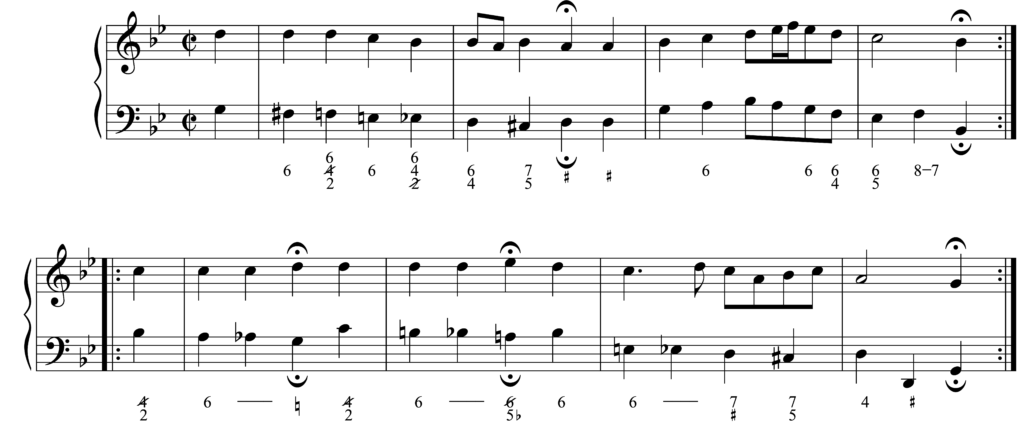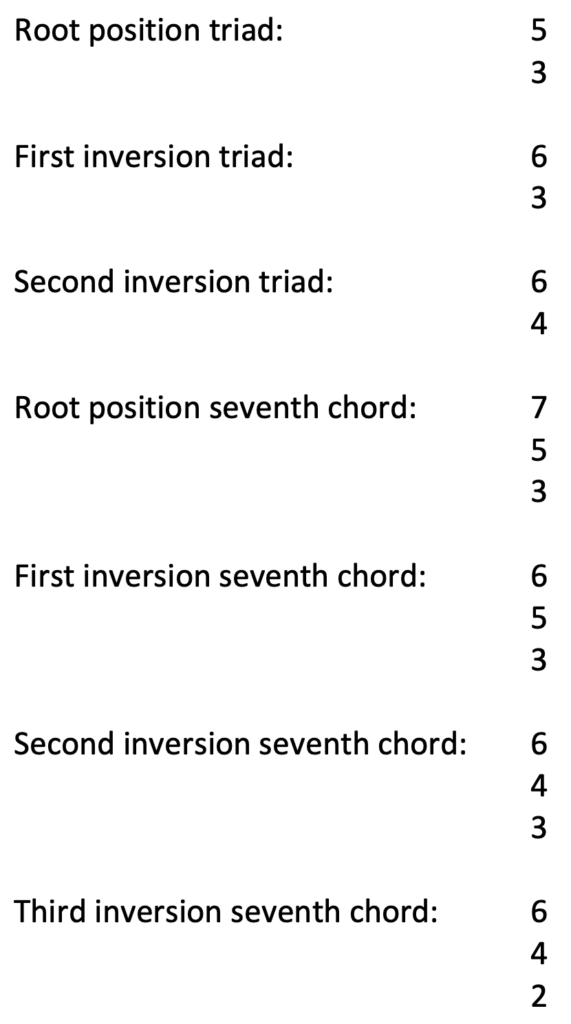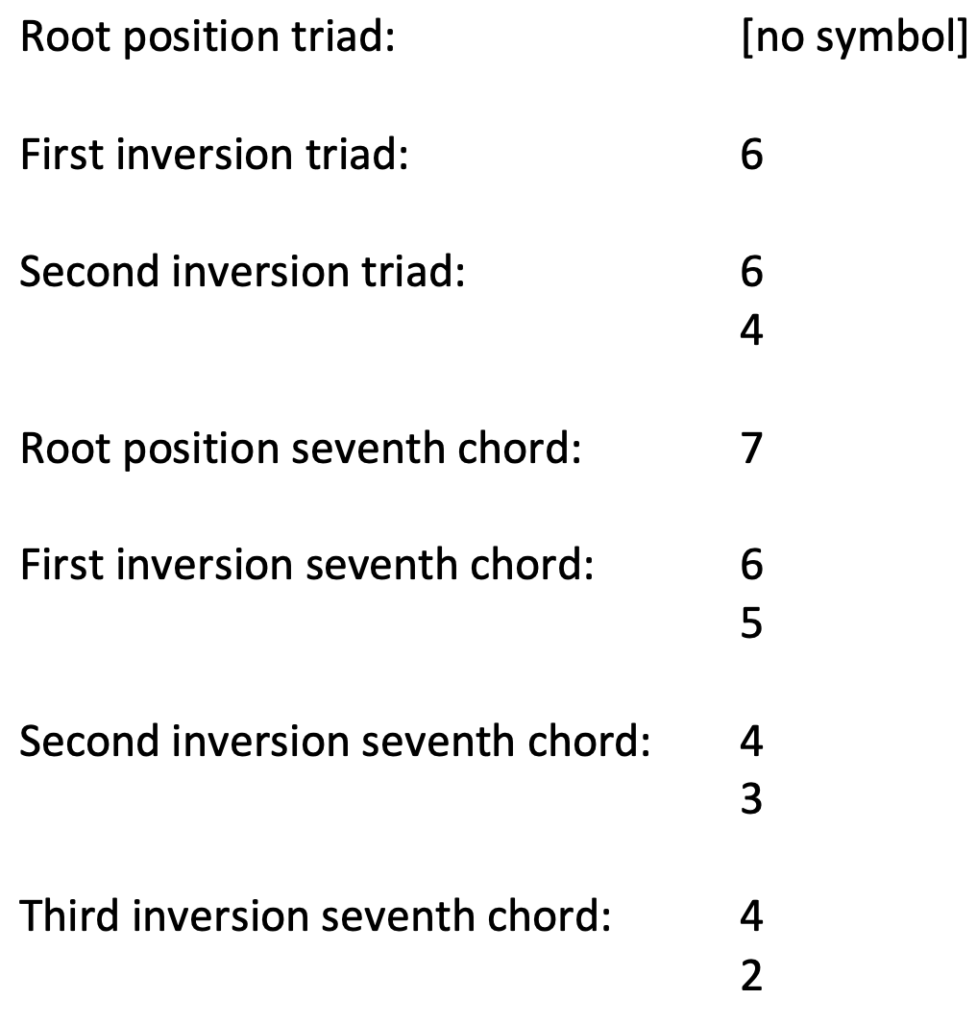Main Body
12 Figured bass
Learning goals for Chapter 12
In this chapter, we will learn:
- How to identify inverted chords
- Figured bass symbols for triads and seventh chords in all positions
- How to analyze chords using figured bass symbols
- How to construct chords using figured bass symbols
Figured bass and chord inversion
Triads and seventh chords may appear in , which occurs when the root of the chord is also the bass or lowest note, or they may be , which occurs when the third, fifth, or seventh is the bass note. The chord is in when the third is the bass note, when the fifth is the bass note, and when the seventh is the bass note. Example 12‑1 shows a triad and a seventh chord in all positions.
Example 12‑1. All positions of a triad and a seventh chord
Example 12‑1 also shows symbols, which are shorthand for chords in various positions. Figured bass symbols originated in the Baroque era in Europe as a system of indicating chords with as little information as possible for improvisation, much like how chord symbols are used today for lead sheets in jazz and various popular genres. Example 12‑2 shows a chorale harmonization by J. S. Bach from 1736, which uses figured bass symbols.
Example 12‑2. J. S. Bach, “So gehst du nun, mein Jesu, hin”
Listen to a recording of this example, performed by soprano Sibylla Rubens, on Spotify.
Learn about German composer Johann Sebastian Bach (1685–1750) by reading this Oxford Music Online article, written by Christoph Wolff and Walter Emery.
Figured bass symbols simply show the intervals above each bass note. This system can be used for both performance and analysis, allowing chords to be constructed or improvised with just a bass note and a figured bass symbol. Example 12-1 above shows both the full and abbreviated figured bass symbols. The full symbols are more complete, showing all intervals above the bass, but using them quickly becomes cumbersome, so the abbreviated symbols are more commonly used. To become fluent with figured bass, you should memorize both the full and abbreviated symbols.
Figure 12-1 shows all of the figured bass symbols at a glance. The black numbers show the abbreviated symbols, and the grayed-out numbers are those that are only included in the full symbols. Note that in the abbreviated system, no symbol at all indicates a root position triad (![]() ). The full and abbreviated symbols are written out and labeled in Figures 12-2 and 12-3 respectively.
). The full and abbreviated symbols are written out and labeled in Figures 12-2 and 12-3 respectively.
Figure 12-2. Full figured bass symbols
Figure 12-3. Abbreviated figured bass symbols
Figured bass symbols may be modified in several different ways. Any note other than the bass may be altered (lowered or raised) by placing a flat, natural, or sharp symbol to the left of the number. Another method of raising a note by a half step is to place a diagonal line (slash) over a figure. Finally, if only a flat, natural, sharp or slash symbol appears with no number, the symbol applies to the third above the bass, which is assumed. Modifications are used only for chromatic notes, i.e., those outside of a key signature. Several examples of these modifications appear in Example 12‑3.
If the position or identity of a chord is not immediately apparent, the best way to make sense of the chord is to rearrange the notes in a stack of thirds. Once the chord is arranged in this fashion, the bottommost note will be the root of the chord, and from there you can determine the quality and inversion by comparing it to the original chord. Example 12‑4 demonstrates this process.
Example 12‑4. Identifying chords in various configurations
Video: T28 Intro to figured bass, part 1 (7:54)
This video explains what figured bass is, how it emerged, how it was used for improvisation and performance in the Baroque era, and how we use it as an analytic tool today. In addition, this video introduces the figured bass symbols for triads.
Video: T29 Intro to figured bass, part 2 (5:08)
This video introduces the figured bass symbols for seventh chords.
Quiz on figured bass symbols
Video: T30 Figured bass modification symbols (2:39)
This video briefly introduces a few of the most common modification symbols used with figured bass.
EXERCISE 12-1 Figured bass identification
For each of the chords, provide the root, quality, bass note, and figured bass symbol. You do not need to add modifications to the figured bass symbols, since the chords are taken out of a tonal context. You may use either the full or abbreviated figured bass symbols, or whichever your instructor prefers. The first is done for you.
SET 1
SET 2
SET 3

SET 4
EXERCISE 12-2 Figured bass chord construction
Given the bass note and figured bass symbol, spell each chord on the staff below or on a separate sheet of staff paper. When modifying symbols are given, raise notes by adding a sharp, and lower notes by adding a flat. The first is done for you.
SET 1
SET 2
SET 3
SET 4
Supplemental resources for Chapter 12
designation for chords whose lowest note is also the root of the chord
designation for chords that feature a member other than the root as the lowest note
position of a chord when its third is the lowest sounding note
position of a chord when its fifth is the lowest sounding note
position of a chord when its seventh is the lowest sounding note
symbols used in European Baroque music, appearing beneath a bass line, upon which musicians would realize chords














